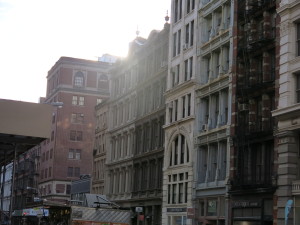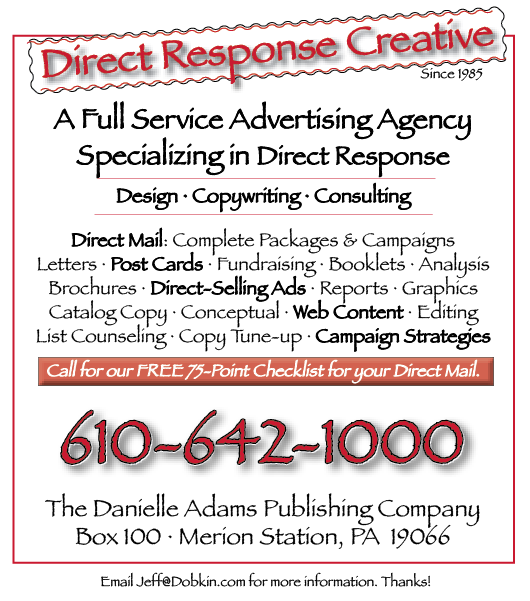How I Quote for Creating a Newspaper Ad
By Jeffrey Dobkin

How to Quote newspaper ads
The client cost to create my own style of Long-Copy Direct Response Newspaper ad is $2,500 to $5,000 for a quarter page ad, and $5,000 and up for a half page ad. “Whoa – that’s expensive!” is the first reaction I get from some clients who think I whip ads out in an afternoon.
Truth be told, ads from me take about 30 to 50 hours to complete. They are one of my favorite pieces of art and copy to write and design, and over the past 25 years I’ve learned how to be unbelievably effective at making my client’s phone ring. My ads are quite different than everyone else’s ads except for a few of my direct-marketing students who have taken my seminars and classes.
Here’s how my quote is figured:
3-4 hours preparatory work.
Client telephone time, web research, wording research. This is the information gathering stage where I write everything down.
4 hours creative time.
I study my notes, and I make even more notes. I write down offers and copy ideas. We have client discussions. These ideas congeal into the writing of the first draft.
In this time slot I usually hand draw a rough sketch of the ad so I can get an idea of the layout, where each headline will be used, graph, product illustration or photo, and the weight and feel of the type (for size and type density.) Even though when I am assigned copywriting only, I’ll still need a feel for the value of each headline and subhead, and the density of the typed copy.
2 hours headlines. Sometimes 3 or 4 hours.
Three or four sessions of writing headlines over 2 days. I usually write a few dozen headlines and sub-heads to start, hoping I get hot. OK, when that doesn’t work I continue to write – sometimes up to 100 headlines or more. Starting out with a few sheets of blank paper, I fill them up with headlines, proposed headlines, headlines that won’t work but since this isn’t the time to edit I write them all down anyhow; notes, doodles, things I thought were brilliant but later can’t decipher, and more notes and scribbles. Then the editing process begins: after I assure myself I have enough headlines to work with, I go back and pick out my best ones – using precision in where they fit-in best. This time-allotment includes writing all headlines and subheads – including main headline, gray box headlines, black box titles, and photo captions — with forethought into the best tactical transitional lines (that come after the headline, leading into the subhead or body copy). Great transitional lines keep a reader in the copy.
7-8 hours, Copywriting.
Now I write prolifically, later I edit severely and just leave the best on the page. Write and refine, write and refine. Sometimes it comes out fast, sometimes slow. Sometimes I write 3,000 words to get 1,000 of the best. Sometimes 5,000.
This segment of raw writing from my earlier notes is generally done over two to three days so I can see it fresh – several times. I may add more research at this time. Sometimes this process takes half the time but that’s not the way to bet. More commonly it takes double the time. Writing is sometimes fast, editing is always slow. Sigh…
6-8 hours, Design and copyediting.
This is where I bring my best copy and offers forward. In this stage I have the main content, but it needs additional and sometimes severe editing because it all won’t fit. It never does… ever. So I edit severely, keeping the client’s salient points, the benefits, and the parts that make the phone ring. I may send a client the raw copy to make sure we are on the same page before I start to lay it out; most times we’ve already talked about it enough and this isn’t necessary.
Adobe InDesign is my page-composition software of choice and I start the layout of the ad by framing out the exact size the ad is to appear. The copy is then floated in sectional copy blocks. At the end of this stage clients get to see a Rough Draft. The rough draft is to make sure I’ve included all the copy points they’d like to see in the ad, and all the selling points I need to make their phone ring, and the right amount of time spent in between to seduce people into buying my client’s brand of the product. But mostly I just try to make the phone ring – that’s the objective of most of my ads: to make the phone ring.
The layout is then roughed-out to see what fits, what looks best and where. In the ad design, I place what I want to bring out and emphasize, and deemphasize what needs to be in the background. I design-in where I want the reader’s eye to go first, second, next and last. I increase the type size of what I want readers to see at a glance. What the skimmer or page-turner will notice before getting away, in the hopes to bring him or her back into the ad.
I move front and center what I want you to read – starting with the most interest arousing copy headlines and titles and leading down into the sales copy and making the you – the reader – call. This is accomplished with good type positioning and placement, and finesse in the weight and style of the type.
Copywriting Insight: By the way, it’s not unusual for me to say “Call” up to 10 times in the ad, and show the phone number almost as many times. In this regard, The CTA is repeated throughout the ad. I try to make the value propositions valid, vivid and well documented, then ask the reader to call. I feel this is the correct orientation of the ad: if no one calls, the ad fails.
2 Hours, copy corrections/Authors Alterations.
The rough draft may or may not need changes, no way to tell until it’s presented. I don’t like to finish the ad before a draft is submitted because if there are changes that need to be made, it’s easier to make at this point.
In assignments that are copy-only, changes are faster, and may result in a reduction of hours. On the other hand, if there are significant changes, I never bill over the allotted time estimates I quote. I always try to come in under budget, never vice versa.
2-3 hours, final readings, final edits, fine tune design.
Only by reading and rereading, hard proofing, and final edits over a period of a few days can I assure the best and smoothest transitions, placing final CTA’s, and making sure everything I want to say, everything the client wants to say is included. I also methodically, line by line and point by point, set the leading (space between lines) and type sizes. I generally have read the ad copy so many times by the end of this stage — I have it memorized.
Final copy is then sent. If there are any last minute changes or corrections, I’m pleased to do them at this time and they are usually included at no additional charge. Since the client and I have both had a pretty good look at everything over this time period, there are generally no surprises at this point.
Heavy changes made now are billed additionally, at my open rate. I say this for the few, the 1%, of clients who continually make changes to a finished piece up until the time the ad or project goes on press, and the 1% of clients who make changes at the last second. Hey, some people just work best in hindsight, and that’s OK, they just have to compensate me for additional time. To make it harder and more complex, last minute changes are usually at this point a rush against a deadline! If they make additional changes that take me 8 hours and I have to now create huge copywriting changes and redesign the entire final ad, I do it. Some people work this way and this is part of their process. I’m ok with that. Unfortunately those same changes could have been made early in the project, way before the final layout at 1/3rd the cost, if there were any additional charges at all – because I’m pretty good about working with clients and changes. But now all that additional time, well… that’s on them. They receive a bill for client alterations. I always tell clients this, and always advise them they will be billed for additional time so they know. No surprises with a big bill at the end. I don’t ever charge clients without advising them first – I don’t think that’s ethical.
So go ahead – ask for a quote. I always appreciate the opportunity to quote – that’s how every job starts, whether it’s letter writing, graphic design work, marketing plans, copywriting, catalog analysis, consulting, whatever. You can actually see what I do HERE. Well, that’s my process – no longer a secret. If you need anything, please give me a call: 610-642-1000, I’m ready to start whenever you need an effective direct-selling ad, direct mail package, letter, brochure – whatever. Call with questions, or to schedule a longer, fact-gathering phone call at your convenience.
There you have the secret inside track of exactly how I create a direct selling ad, and the parameters of how I base a quotation for my creative services. 610-642-1000 rings on my desk. Thanks. You can see a copy of one of the newspaper ads I’ve created by clicking here. Please don’t forget to sign up for our newsletter – click here. Thanks.
Jeffrey Dobkin

Call for a quote or FREE consultation